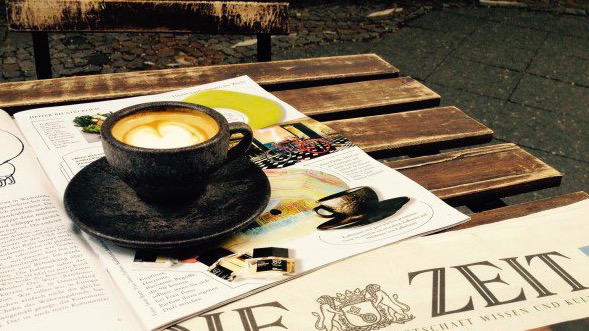Real coffee cups: cups and saucers made from coffee grounds
A German company called Kaffeeform has created a trendy coffee cup and saucer by mixing coffee grounds with biopolymers. The coffee cup set is durable, dishwasher washable and even smells like coffee.
Every time you make a cup of coffee, you leave two tablespoons of coffee grounds. Although the amount left may seem small, the problems that arise when millions of cups of coffee are consumed around the world every day cannot be underestimated. Yes, some coffee grounds are recycled as fertilizer or facial masks, but most of them end up in the trash. German product designer Julien Richner was thinking about this when he came up with a bold and novel way to recycle coffee grounds sustainably-by turning them into coffee cups.
Richie came up with the idea of using coffee grounds to make eco-friendly pottery while attending university in Bolzano, Italy. "We drank coffee every day in college, before class, after class, at parties with friends, at coffee bars…all the time," he recalls. So I started thinking, can these leftover coffee grounds just be thrown away?" He began discussing with his professors how to turn the coffee grounds into a solid material, but it took them years to find a workable solution.
"We tried different adhesives and even tried sugar." Julien Richner said on Vice Munchines,"Although the ingredients are very close to coffee grounds, it is basically a 'sugar cup' and melts after three uses." Making the material stronger and more durable was the central problem, so he and his partners started from scratch at a research institute in Germany. After countless failed experiments, countless long nights, and countless liters of coffee grounds, they finally created the dream material, which is a mixture of coffee grounds, wood, biopolymer materials such as cellulose and lignin, and natural resins.
Richner recalled being ecstatic to learn that the glass would not melt and would stand firm. "After studying it for so long, you have to believe that the idea is feasible and that it can eventually be realized." When I drank my first cup of coffee brewed in this cup, I had mixed feelings. The wait was not in vain." The icing on the cake is that his invention has also achieved commercial success and brought economic benefits. There are ten brick-and-mortar stores in Europe selling Kaffeeform coffee mugs, but demand is still in short supply, and the company's online store sells out every once in a while, and they've only been open for a year.
"Coffee mugs are basically sold by word-of-mouth," Ritchner said of the company's success. Orders come from different places, some of which are really unexpected. There are many individual customers buying, as well as orders from coffee shops in Saudi Arabia and the Ritz Carlton in Toronto. Even the museum in Oslo, where the Nobel Peace Prize is awarded, sells Kaffeeform coffee cups.
Kaffeeform will soon be mass-producing a cappuccino cup that can also be used as a travel mug. But these are short-term projects, and Richner hopes to create practical things out of recycled coffee grounds in the future. "What's next? I want to see if I can make sheets out of it." "Maybe coffee grounds could one day be used to make furniture for cafes and restaurants," he said.

Important Notice :
前街咖啡 FrontStreet Coffee has moved to new addredd:
FrontStreet Coffee Address: 315,Donghua East Road,GuangZhou
Tel:020 38364473
- Prev

Starbucks collided with McCoffee.
Last year, consumers who prefer pumpkin-flavored coffee have already tasted the benefits of Starbucks pumpkin-flavored Frappuccino packaged drinks launched on Costco. This year, in an effort to catch up with these sweet lovers, Starbucks announced another limited edition of pumpkin-flavored latte K-cup drinks. It is accompanied by pumpkin-flavored Via instant coffee bags. In the meantime, if you don't mind the big
- Next

Drinking coffee in moderation has five major benefits, good health care methods.
Coffee is a favorite of many people. How many cups do you drink every day? how much do you know about the benefits of drinking coffee? What's good about drinking coffee? the five benefits are the most beneficial. Promote your health care! Drinking coffee often can cheer you up. I'm sure we all know that. A small amount of caffeine in coffee can make people awake, alert, refreshed, and maintain mental concentration in work and life or study.
Related
- What is the difference between a cake filter cup and a V60 conical filter cup? What are the advantages and disadvantages of the flat-bottomed filter cup brewing solution?
- What is the difference between fine coffee powder and medium coarse coffee powder? Do I need to sift out the fine coffee powder for making coffee by hand?
- Why does hot American coffee taste bitter? Difference in proportional concentration between hot American and ice American
- Is espresso stored overnight in the refrigerator harmful to your body? Is frozen coffee better than freshly ground coffee?
- What parameters and proportions of water temperature should be used to grind and brew fresh coffee beans? Why can't I drink freshly roasted coffee right away?
- Customers have "changed" Manner's new products! Shop assistant: Please don't mess around!
- Remove sockets in customer areas at Starbucks stores?! Netizen: I won't go if I really tear it down
- What is the difference between the taste steps of sun-dried coffee and washed coffee? Why is sun-cured coffee sweeter and washed coffee sour?
- The recipe for salty grapefruit dirty is revealed! Coffee Festival salty grapefruit dirty coffee making materials parameters ratio milk share!
- How about the flavor of Sunlight 74158 at Sidamo Banshaha Mathieu Processing Factory in Ethiopia? 74158 Share the proportion of coffee brewing parameters!

